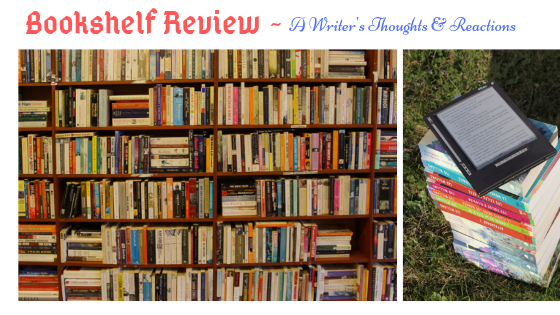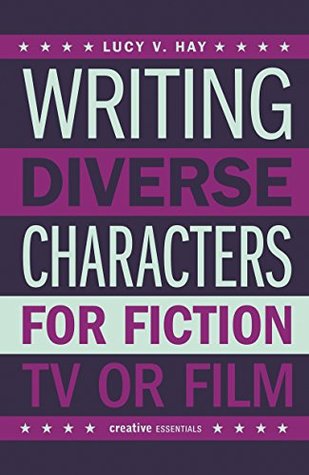
Life has thrown up more diversions – okay, my weak will did. I still intend posting a Thursday Creation Review every week – as originally planned. Well at least until my five outstanding reviews are written – three crime, one historical and one historical-fantasy. I’m hesitating over adding my review of the TV series Good Omens until I’ve read the book.
Anyway, today – a day late – it’s a non-fiction writing guide up for review:
Writing Diverse Characters for Fiction, TV or Film
by Lucy V. Hay
We’re living in a time of unprecedented diversity in produced media content, with more LGBT characters. more characters of color, more disabled characters, and more characters from various religions or classes. These characters also appear in genre pieces, accessible to the mainstream, instead of being hidden away in so-called “worthier” pieces, as in the past. This book discusses issues of race, disability, sexuality and transgender people with specific reference to characterization in movies, TV, and novel writing. Using such examples as the film Mad Max: Fury Road and the novel Gone Girl, the book explores how character role function really works. It discusses such questions as the difference between stereotype and archetype, why “trope” does not mean what Twitter and Tumblr think it means, how the burden of casting affects both box office and audience perception, and why diversity is not about agendas, buzzwords or being “politically correct.” It also goes into what authenticity truly means, and why research is so important; why variety is key in ensuring true diversity in characterization; and what agents, publishers, producers, filmmakers and commissioners are looking for—and why.

Review 5 stars
This timely and excellent book was everything I’ve needed especially since attempting to write a novel about a queer Welsh detective and her Tamil partner. (There are days when I feel totally out of my experience zone.)
This is essential reading for any serious writer – especially one aware of the value in addressing the ‘diverse issue’. It was full of invaluable advice and information for me – a WASP, albeit one with Latin blood and in a wheelchair.
Lucy Hay has researched the hot issue of ‘diversity’ for many years. She has become a prolific advocate of diverse characters in all areas of fiction as a writer, script editor and blogger who helps writers via her www.bang2write.com consultancy, which I follow. This book builds on her knowledge and suggests how writers can embrace the thorny topic – “as long as they do it justice” with “due diligence”
That ‘due diligence’ means recognising where the debate is going, the mistakes and progress, how to ensure diverse characters function effectively – and not as stereotypes – plus, the potential and the pitfalls. Hay provides a wealth of observations, suggestions and links with which writers can develop their own craft. Many assets are provided to inform those that are serious about ensuring they tread wisely.
These range from a definition of ‘diversity’, and the myths surrounding it, to examples from modern movies and novels to explain aspects of how to handle ‘diversity’ – and how not to. All Hay’s thoughts provide food for further discussion and research.
I’m still learning and researching the best approach to diversifying my plots. This book has great insights that will help me as a writer as I progress into this complex area. Many of my characters are not ‘diverse’ like my leads, but there are techniques that Hay provides which will help them stand out as unique as well.
This book is timely and important so a guide that will be a stalwart on my desk as I now have both Kindle and paperback versions.
Utility – five stars
Content – five stars
Topicality – five stars
Authenticity – five stars
Readability – five stars
Structure – five stars
Editing – five stars

Okay, so… you really, really liked this book… 🙂 Writing diverse characters is very important these days, as is avoiding being accused of appropriation. I am doing something for an education publisher, which has a set of guidelines about what MUST be included in your book and what can’t be,e.g no dogs or pigs, as the book may go to Muslim countries, no Australian settings as it might go to the US, etc. And make sure you have diverse characters. As I’ve taught kids from South Sudan, I wrote my 160 word story about a family, who will be drawn black, taking their pet goat to compete in the Goat Cup(The sound du jour was “oa”), though not in an African setting, because you have to be vague. I hope I don’t get into trouble for assuming that an African family might own a goat. It’s just that I needed to use the sound “Oa” and I had to use diverse characters, so I went for one I was comfortable with because I’d worked with Sudanese colleagues and students… In fact there is a school goat at the primary school where I volunteer, and I took photos of her for an art reference. But you can get into big trouble for appropriation or being offensive with cliches. The editor thinks it’s okay, but she’s British, and I’ve had to rewrite for the American market before.
LikeLiked by 1 person
The hoops writers have to negotiate, so full marks Sue. Ticking the right boxes and evading the pitfalls has got hard. Avoiding appropriation is a challenge for any ‘WASP’ writer – even if one ticks the ‘gender’ box. I’m now worried about the goat in a short MG story I’m writing – set in the Crimea in 1944.
LikeLike
Thank you.
Politically correct is a term I am not comfortable with. Actually being politically correct means not saying things which will demean/diminish and hurt others. And yet somehow the phrase has been twisted into a negative thing.
I love that diversity is (in some areas) being celebrated, and has an increased recogntion even among those who don’t celebrate it.
Climbing down from my soapbox now (carefully because my balance is not good). I am really glad that you found this book valuable.
LikeLiked by 1 person
Balance is important – as we know, EC. We live in sensitive times – or have people always done that? Now to ensure I write what works.
LikeLike
Great review, I’m going to check it out!
LikeLiked by 1 person
If you are interested in the diverse issue, it’s worthwhile, Maria.
LikeLike
My own character writing has not been very diverse though the stories have usually been focused on specific communities. If I start writing more and for actual publication then I should probably have a greater diversity in characters.
Lee
LikeLiked by 1 person
Our communities do have a great bearing on our writing, Arlee. I suspect I stepped out of mine, although the horse world had a percentage of diverse characters.
LikeLike
Pingback: #IWSG – Writing Craft | Writing Wings